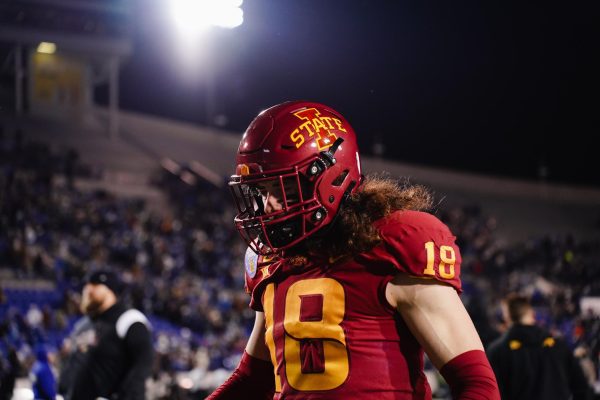They are gone, but not forgotten
April 9, 2008
Editor’s note: This is the second in a two part series looking back at a plane crash that killed two ISU student-athletes and another ISU student. Part one appeared in Tuesday’s Sports section.
Former ISU track coach Bill Bergan is proud of the great relationship he was able to cultivate with Jeff Myers and Brian Vincent during their time on earth. Although he only knew the duo for a relatively short time, they still made a lasting impression on his life.
“I felt that I had a great bond with the two of them and know that we all meant a great deal to each other,” Bergan recalls. “They were the type of guys that you would want your kids to be friends with. They were great people who constantly thought about what was best for others before thinking of themselves.”
It wasn’t just Myers and Vincent – all the passengers aboard that doomed flight had qualities that endeared them to their peers. The memories from their time on Earth allows their spirits to remain vibrant even today. For some, these recollections provided moments of laughter, while others were agonizingly painful. Each helps, in its own way, to make sure that victims are never forgotten.
Jeff Myers
To Jeff Myers, the past meant nothing.
Although the ISU track team had finished at the bottom of the conference 21 of the last 25 years, that dreadful statistic was meaningless to him. Jeff saw it as a chance to make a difference and turn around a long-suffering program, and turned down other scholarship offers for the opportunity to be a Cyclone.
Jeff chose Iowa State not only for its track program, but for its academic programs. Since he was a little kid, being outdoors and around animals were vital parts of his life. He would often bring home animals of all shapes and sizes to take care of them. When it came time for him to choose a school, Iowa State seemed to be a natural fit. In Ames, he had the opportunity to pursue both of his interests, majoring in veterinary medicine while participating in track and cross country.
In his freshman season, Jeff was able to leave his mark at Iowa State. He was instrumental in helping the Cyclones win their first Big 8 title in 43 years.
In the years to follow, Jeff continued to make a name for himself in the world of track. Two of the victories he posted during his sophomore season remain legendary accomplishments 30 years later.
As a 19-year-old, Jeff finished the 1500-meter run in a time of 3 minutes, 41.3 seconds, marking the first ever sub-four-minute mile in Iowa State history. His time was so good that it ranked in the top two in the nation for his age group. By achieving that feat, Jeff automatically qualified for the 1976 Olympic trials.
The second highlight of his magnificent sophomore campaign is considered to be the turning point in the history of the ISU track program. At the 1976 Drake Relays, Jeff was the anchor leg of the Cyclones distance medley team. By the time he received the baton, he found himself trailing three of the best runners in the nation. Jeff was able to make up the deficit and capture Iowa State’s first victory at the Relays in 31 years.
The importance of the distance medley relay is not lost on Bergan. Without a doubt in his mind, he considers that signature win the most important in school history.
“At the time, the Relays were a much bigger event than they are now. Back then, all of the top recruits in the country were there to see Jeff win that relay for us. That one event helped to recruit the upper-level track athletes that we weren’t able to before,” Bergan said.
Being able to recruit and sign highly regarded athletes such as Scott Crowell and Brian Tietjens was instrumental in changing the fortunes of the track program. The exposure garnered from Jeff’s performance was the key reason Iowa State established itself as a dominant program in the 1980’s.
After he won the 1500-meter race at the 1977 Big 8 indoor championships, Jeff received the highest distinction possible for a collegiate athlete when he was named an All-American. In the process, Jeff became the first Cyclone distance runner to earn the lofty distinction since 1932.
Despite his enormous success, Jeff is remembered as being very humble. His teammates can recall one specific example of his caring persona.
At a 1977 track meet in Cedar Falls, Jeff and teammate Brian Vincent were competing against one another in the mile run. Near the end of the race, Jeff knew that he was clearly winning the event. In situations similar to this, it was his habit to take a peek over his shoulder and locate his teammates. This time, when Jeff glanced back, he noticed that Brian was all alone in second place. Instead of crossing the finish line, Jeff slowed down to a trot and kept shouting words of encouragement to Brian. Ultimately, Brian overtook Jeff and won the event.
The trait of Jeff’s that Dennis Barker will always remember is his uncanny ability to make others laugh.
“Jeff was a real fun-loving type of guy. He made practice fun to go to because you wanted to see what practical joke he would pull that day. He enjoyed it so much that most of the time he could hardly contain himself. After he let out that huge laugh of his, you could never stay mad at him.”
Jeff was always able to find a way to make people laugh, even if it was unintentional. Jim Ijams became well aware of this when he lived with Jeff for a short while.
“In our house, we had this iguana named Bert. Jeff felt sorry that it always had to stay in his cage, so one day we decided to let him out and run,” Ijams said. “As soon as we put Bert on the Astroturf, he took off. We did not realize how fast he was at the time and ended up spending half of the night chasing him around State Gym.
“I will never forget that the whole time Jeff was chasing this iguana, he kept laughing hysterically.”
Jeff loved being around animals his whole life. He first exhibited this passion when, at a young age, he found abandoned animals and cared for them as if they were his pets. To ensure that none would starve, Jeff would set his alarm clock to all hours of the night so he could wake up and feed the animals.
Jeff’s passion for animals did not wane as he got older. During the summers when he was in high school and college, Jeff would work as an assistant at the Quad Cities veterinary clinics.
“If he were here today, I can’t envision him doing anything else with his life except for being a veterinarian. The profession was well-suited for him since Jeff wasn’t in love with big cities,” said Craig Myers, Jeff’s only sibling.
Laura Vernon
Although they were separated by a few years, Sharon Waterstreet has great memories from the time she spent with Laura Vernon.
“I was younger when Laura was an upperclassman,” Waterstreet said. “With our age difference, the only time I really talked with her was on bus rides to and from the meets. Those conversations were great because she ignored my age and treated me no differently from anyone else.”
As a walk-on on the ISU diving team, Laura primarily competed at a height of one meter. Over the years, she improved so much that she was eventually awarded a full-ride scholarship. Yet she considered athletics second to academics.
Although she was usually a mild-mannered person, Laura introduced herself to boyfriend Jeff Myers in the most unusual way.
“There was a tradition on the men’s track team to have a pie fight with one of the girls’ dormitories on campus. When Jeff was not paying attention, Laura managed to sneak up close and hit Jeff directly in the face with a pie. As Jeff cleaned himself off, the two of them talked and really hit it off,” said Craig Myers.
Those who remember Laura describe her as an outstanding student who enjoyed nothing more in life than spending time with her friends. As her old friend Cindy Maltry will attest, Laura was happiest when she was able to make her friends laugh. One of the best examples of Laura’s sense of humor was the time she walked around a hotel with a pair of clean underwear on her head
“Laura had this real long hair which she usually kept in purple braids. She took one braid and put each into a different leg hole. I think that if she were here today, she would still have a good laugh about that herself,” Maltry said.
Brian Vincent
Throughout Brian Vincent’s life, success seemed to follow him wherever he went. No matter what he tried his hand at, Brian seemed to have the golden touch.
Yet younger brother Kent insists that it would have been impossible to learn this just by just talking to him.
“Brian was really humble and down-to-earth, which comes from his Midwest upbringing. He would never come out and say directly to your face that he had the top GPA on the track team,” Kent said.
Of all his accomplishments, Brian’s academic achievements were clearly the most impressive. At Pleasant Valley High School, he was a fixture on the honor roll and was named a National Merit Scholar. When looking at schools, he seriously considered attending MIT or CalTech, but declined because he felt they did not offer a well-rounded college experience. While at Iowa State, Brian kept up his academic prowess, maintaining an overall GPA of 3.89. Every year, he possessed the highest GPA on the track team.
Gene McGivern cites the dedication that he showed everyday as the reason for his immense improvement.
“In a good sense, Brian was an overachiever,” McGivern said. “His athletic ability was not the greatest but, he outworked people. He kept trying to get better, which ultimately allowed him to really blossom.”
Despite all his training, it was extremely rare for Brian to ever get new shoes. As Steve Gering remembers, the man he called Vince had a special concoction that he used instead.
“He had this stuff that was called shoe goo where he would just keep adding new layers with a hot glue gun. That stuff would cause Vince’s shoes to last longer than anyone else’s on the team,” Gering said. “While most of us would go through four or five pairs, Vince took such care of his that he wore the same pair all year.”
Brian learned how to be resourceful when as a child when he partook in the Scout system. As he ascended to the rank of Eagle Scout, Brian spent many trips camping and scouting the wilderness, which led him to gain a new appreciation of nature.
As time passed, Brian’s love for the outdoors grew stronger. Dating back to his junior year of high school, Brian would spend his summers working at Camp Minneyata outside of Dixon. After working at the camp for a total of five years, Brian was eventually awarded the title of nature director for Camp Minneyata.
During his time at the camp, Arlene Vincent affectionately referred to her son as “The Pied Piper.” In place of mice, Brian had children of all ages following every footstep he made on his journeys.
“Over time, he became very good with children. It was not an unusual sight to see Brian surrounded by kids,” Arlene said.
Many, including Brian’s sister Rene, felt his future job would be forestry-related.
“I think that my brother would be leading environmental programs at some type of environmental park. He was really good at teaching things, so I could also see him as a guide at a park or a Boy Scout leader. Whatever he went into would definitely have to be nature-related,” Rene said.
Remembering
In the thirty years since their passing, no one has forgotten the victims of the plane crash. Rather, their memories are honored in a variety of ways.
The most widespread form of respect shown over the years has been parents naming a newborn child after a victim. Gene McGivern, for one, pays tribute to his fallen comrade in this manner.
“When my youngest child was born, I gave him the middle name of Vincent in recognition of Brian,” McGivern said. “The name is not just a tribute, but also a gift to my son. When he gets older, I will sit him down and tell him about two friends that I lost.”
Kent Vincent and his immediate family continue to celebrate his brother’s birthday. Each year, they take out his picture and tell stories of the uncle his children never knew.
In her high school biology classes, Sharon Waterstreet attempts to teach in a way that is unique among others. She tries to make learning fun and always has an genuine smile on her face – two virtues she learned from Laura.
Whether it is something as conceptual as remembering those involved through daily thoughts and prayers or something as concrete as a monument, the importance is that their memory continues to live on. The legacy of their loved ones, no matter how much time passes, should never be forgotten.
















